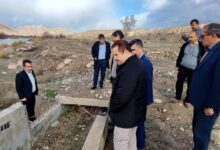Passengers should not travel on Chalus Road and Tehran-North Freeway until further notice/ the beginning of the first wave of Nowruz trips in the country

Ahmad Shirani said in a conversation with the central headquarters of the country’s travel services coordination: “Minutes ago, the Chalus road was closed in both directions from south to north and north to south due to heavy snowfall and rock fall.
He announced the purpose of blocking this route is traffic safety and said: until further notice, passengers should not travel on Chalus Road and Tehran-North Freeway, and travel on other routes such as Heraz, Firozkoh and Qazvin-Rasht to go to the north of the country or return from there. do
Shirani also stated about the cars that were stopped along this axis: the necessary arrangements are being made to unload the traffic load from inside the Chalus axis and these cars will be removed from the road in compliance with the safety measures.
He said about the traffic situation of the country’s roads: according to the reports received from the traffic control centers of the traffic police across the country, although the Chalus road is blocked due to snow and rock fall and no new traffic load has entered this axis, but in the area of the bridge There is heavy traffic from Zanguleh to Siah Bisheh on the south-north route. Necessary measures are being taken to relieve the traffic load of this road, and until this axis is blocked, traffic will be carried out through the alternative routes of Haraz, Firouzkoh and Azadrah Qazvin-Rasht.
He reported heavy and semi-heavy traffic on the route from south to north of Haraz axis in Belde area and said: on the Qazvin-Karaj freeway in the area of Shahid Kalantari terminal and Fardis bridge, Karaj-Qazvin freeway in the area of Golshahr and Hesarek bridge and the Shahriar-Tehran axis. There is heavy and semi-heavy traffic in the area of Maidan Square.
The head of the Traffic Information and Control Center of the Faraja Traffic Police said: We are also witnessing an increase in traffic in most of the intercity roads, which shows that the first wave of Nowruz trips has been formed according to the forecast. The information received from the traffic counter systems shows that the traffic outside the city has increased by 12% compared to the previous day. The peak traffic hours are between 17:00 and 18:00 and the lowest traffic is between 4:00 and 5:00 in the morning.
Shirani identified the axes with the most traffic on the second day of the implementation of the police Nowruz plan on the roads, respectively, Karaj-Qazvin freeway, Karaj-Tehran freeway, Tehran-Karaj freeway, Qazvin-Karaj freeway, Qarchak-Ray freeway, Qom-Tehran freeway, Saveh freeway- Tehran, Shahriar-Karaj, Tehran-Saveh freeway and Tehran-Qom freeway have been completed.
He also said about the weather condition of the roads: reports indicate snowfall in some axes of Alborz and Qazvin provinces. Rain has also been reported in some areas of East Azarbaijan, West Azarbaijan, Ardabil, Tehran, Qom, Mazandaran, Kurdistan and Gilan provinces. It is necessary for drivers to drive through these axes at a safe speed and keep a proper length distance from the opposite car.
The head of the Traffic Information and Control Center of the Faraja Traffic Police announced the number 120 and asked the drivers and passengers to call this number before starting their journey and knowing the latest weather and traffic conditions on the roads as well as the axes with blockages and traffic restrictions. Choose the most suitable time and route for your trips.
end of message/

